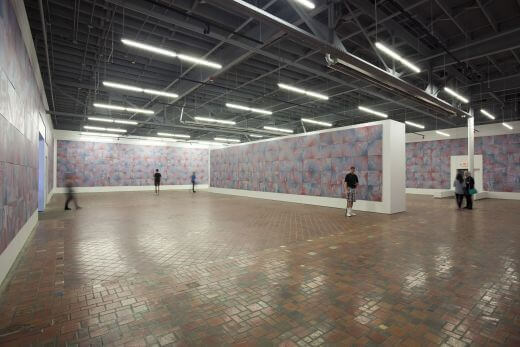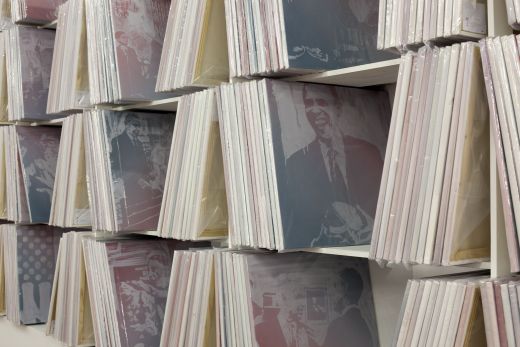The Obama Paintings: Rob Pruitt
with Hunter Braithwaite

Installation view, The Obama Paintings, Museum of Contemporary Art Detroit, 2015. Courtesy of MOCAD, the artist, and Gavin Brown's enterprise
The Obama Paintings are both triumphant and melancholic; they show a world leader, promising and delivering reforms; they show a man aging over eight exhausting years. In the paintings’ mauve palette of bled-out blues and reds, one sees the bruises of his approval ratings, his graying hair. Although each is autonomous, the greater project marks the passage of time—something that monuments both depend on and disavow. These paintings, of which there are nearly three thousand, are on display at the Museum of Contemporary Art, Detroit (MOCAD) through August 2, 2015. Pruitt recently spoke to Hunter Braithwaite about the project.
HUNTER BRAITHWAITE (MIAMI RAIL): Help me get a feel for the time commitment necessary for this project. When you say that every day you painted a picture, does that mean that you were in the studio every day? Or did you find yourself having to double or triple some days to stay on schedule? Were you excited when he was reelected in 2012, or did you suddenly feel the burden of four more years?
ROB PRUITT: It’s always been important to me to treat my studio practice like a normal job. Regardless of what’s happening in the studio on any particular day, I arrive in the morning and leave in the evening, like a regular eight-hour workday. That being said, with long-term projects like this one, which span years, there are bound to be days when I’m out of town or sick and can’t make it to the studio, but on these days I’ll still be sure to choose a picture from the previous day’s news cycle and I’ll make up for the delay as soon as I can.
Installation detail, The Obama Paintings, Museum of Contemporary Art Detroit, 2015. Courtesy of MOCAD, the artist, and Gavin Brown’s enterprise
RAIL: You’ve likened the act of painting these images to yoga. Could you tell me more about this meditative element?
PRUITT: I believe that having a structured beginning to one’s day is crucial to being productive. The routine of looking at the news, seeing what’s going on each day with the president, and making a quick painting is a great way for me to set the tone each morning when I get to the studio. It’s not meant to be the main activity.
RAIL: You selected each image from online news articles. Did you pay any attention to the importance of the event, or was there something else that drew you to choose the image to paint that day?
PRUITT: Like any form of documentary, the goal is to represent something truthfully. However, a sequence of images of the president sitting at his desk in the Oval Office does not necessarily make for a compelling project, so it’s really several issues that are in orbit that all come together. The importance of the event naturally affects the images I see in my newsfeed, and then I’m also looking for a dynamic, expressive image.
RAIL: The paintings begin with a blue to red gradient ground applied with a spray gun used to paint cars. It’s serendipitous that they’re being shown in the Motor City, especially with Obama’s Big Three bailout in 2009. Did you have any idea that they’d be displayed at the MOCAD? Why did you decide to work this way in the beginning?
PRUITT: The chromatic and tonal gradation is obviously a reference to the colors of the American flag, and the softening of the colors was a decision I made to steer the project in the direction of the stone palette of traditional monuments and away from the flatness of graphic design. When I started the project I had absolutely no plans as to where to show it, always believing that if it was meant to be shown, a place would become apparent. I had been approached by the curator Elysia Borowy-Reeder of MOCAD about showing my work in Detroit, but at the time she was completely unaware of The Obama Paintings. It was only after months that she visited my studio in Brooklyn and learned about the project. I think it turned out to be the perfect place because of the automotive industry bailout and the relationship the city has had to the presidency. It seemed like a good opportunity to remind a broader audience about the recent history of the city, as well as the resilience and fortitude that its citizens have shown.
RAIL: Would you have done this if McCain won? What drew you to Obama as a subject?
PRUITT: I wouldn’t have done this if McCain won. Obama’s election had me elated, and the project gave me a reason to follow the presidency with the same commitment that I had followed the campaign.
RAIL: While each is a unique painting, the projects’ serial execution and installation gives it the feel of a time-lapse moving image. Are there any videos or films of presidents that interest you?
PRUITT: I grew up in Washington, DC, so the office of the president has always loomed large in my mind. I remember the first time I saw footage of JFK being assassinated in Dallas, or the way the news media covered the Watergate scandal on TV. Just growing up around the monuments to Washington, Jefferson, and Lincoln left a huge impression on me. I also love the Betty Ford Center. Although she wasn’t president, I admire the way she used the legacy and influence of the presidency to help those who struggle with addiction.











